Киев и другие украинские города пережили очередную мощную ракетную атаку России. Из-за этого удара в столице погибло 34 человека, из которых 5 детей. Эта трагедия актуализировала вопрос укрытий, проблему с которой власти никак не могут справиться за все время полномасштабной войны,
«Нас спасло Небо», — так киевлянка Ольга Дидок описывает события 8 июля.
По ее словам, она с ребенком находилась на улице в Святошинском районе столицы, когда начался ракетный обстрел. Женщина попыталась найти укрытие, чтобы переждать воздушную атаку, но двери ближайшего дома, где есть подвал и подземный паркинг, были закрыты.
«Весь эпицентр мы пережили, стоя под воротами места, которое должно было нас спасти», — отметила киевлянка.
Журналисты позвонили по номеру телефона уполномоченного лица, который указан на воротах паркинга.
Там сообщили, что этот подземный паркинг по документам не является укрытием и не внесен в фонд гражданской защиты. Доступ к нему есть только у жителей дома, которые знают специальный код.
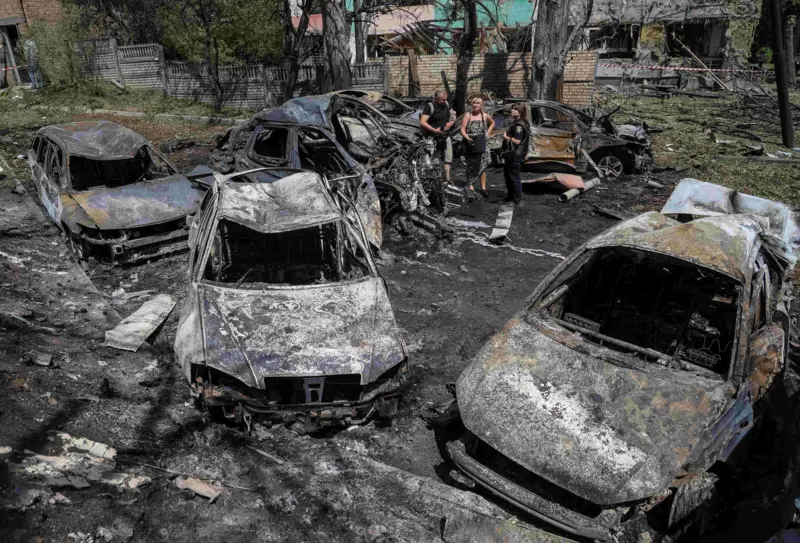
Это не единственный случай, когда защитные сооружения в украинских городах, которые должны спасать граждан, недоступны или находятся в ненадлежащем состоянии, или же вообще отсутствуют.
Казалось бы, проблему должны были бы окончательно решить еще год назад, когда из-за закрытого укрытия в больнице Деснянского района погибли две женщины и ребенок.
Тогда вопрос доступности объектов гражданской защиты вынесли на уровень президента и Совета нацбезопасности и обороны.
Попытки ВВС Украина выяснить, почему проблема до сих пор существует, привели к парадоксальному выводу. В беззащитности украинцев оказалась виновата государственная бюрократия.
Закрытые укрытия
Еще в конце апреля этого года правозащитная организация «Центр гражданских свобод» представила отчет о результатах мониторинга состояния укрытий в разных городах Украины.
Результаты этого исследования довольно неутешительны.
Например, в столице только 53% из 120 проверенных укрытий были открыты или на месте был комендант с ключом. Лишь 18% убежищ имели запас воды и доступ к туалету, а 33% — вентиляцию.
Почти треть укрытий вообще не удалось найти по адресам, где они должны были бы располагаться. Не лучше ситуация во Львове, где были открыты только 25% убежищ, только 6% имели запасы воды, а 11% — вентиляцию. Худшую ситуацию активисты зафиксировали в Николаеве, где были открыты только 7% укрытий.
В убежищах, которые все же удалось проверить правозащитникам, они обнаружили существенные проблемы с наличием воды, туалетов, сидячих мест и даже света. Однако самое главное — лишь незначительная часть укрытий были доступны для маломобильных групп населения, например, пенсионеров или лиц с инвалидностью.
Это связано с тем, что многие укрытия по факту являются подвалами старых домов, особенно в Киеве и Львове. Там просто отсутствует конструктивная возможность установить пандус или пологий спуск для лиц с инвалидностью.
Только половина
С июня 2023 года за ситуацию с объектами гражданской защиты отвечает министр по вопросам стратегических отраслей промышленности Александр Камышин. До этого ответственность за состояние укрытий была «распылена» между ГСЧС (Государственная служба по чрезвычайным ситуациям) и местными администрациями.
Правда, и сейчас только местные власти на свое усмотрение решают, где, как и за какие деньги строить укрытия, отмечает ВВС Украина профильный замглавы минстратегпрома Тимур Ткаченко.
«Наша роль — координация и контроль вопроса приведения в надлежащее состояние сооружений гражданской защиты», — объясняет он.
Чиновник отмечает, что до 2022 года вопрос укрытий вообще не был на повестке дня. В то время фонд защитных сооружений составлял около 20 тыс. объектов по всей стране. Туда входили как подвалы жилых домов, так и противорадиационные бомбоубежища.
С начала большой войны этот фонд вырос втрое и теперь в Украине есть почти 62 тысячи укрытий. Но и этого недостаточно.
«Это позволяет сегодня защитить, если говорить обо всем населении, чуть больше 50%», — говорит Ткаченко.

За этот и прошлый годы власти привели в надлежащее состояние, включающее ремонт и строительство, почти 7,3 тыс. объектов защитных сооружений, на это потратили в общей сложности около 9 млрд грн.
Приоритетом было развитие укрытий при учебных заведениях и медицинских учреждениях.
Отслеживать ход работ можно на специальном сайте минстратегпрома «Железное укрытие». Там указано, какие работы и по какому адресу ведутся и сколько это стоит.
Также существует специальный чат-бот в Телеграме, чтобы люди могли оставлять жалобы на закрытое укрытие или ненадлежащее его обустройство.
Но чтобы обеспечить укрытиями все население Украины, надо построить или обустроить еще 60 тысяч таких объектов.
«Это невозможно сделать только за счет бюджета Украины. Таких денег нет даже приблизительно», — говорит заместитель министра.
Стоимость таких работ он оценивает в 50 млрд долларов. Это больше чем размер дефицита украинского бюджета на этот год.
Кто балансодержатель?
Однако, прежде чем говорить о деньгах, надо разобраться с самым простым вопросом — почему укрытия закрыты во время тревог?
Глава департамента муниципальной безопасности Киева Роман Ткачук объясняет, что это связано с несовершенством украинского законодательства. В частности с тем, что частных владельцев зданий практически невозможно заставить включить их паркинги или подвалы в фонд защитных сооружений, а во-вторых, заставить привести их в порядок и потом пускать людей в эти убежища.
«У нас сегодня руководители компаний, которые даже и не являются собственниками зданий, а просто арендаторами, решают, кого впустить или нет. Во время воздушной тревоги не так важно, в каком состоянии укрытие. Нам очень бы хотелось, чтобы все было отремонтировано, чтобы было инклюзивное, но, к сожалению, такого еще нет. Главное, чтобы оно было открыто», — заявил городской чиновник.

Обеспечить это принудительно возможно только на тех объектах, где балансодержателем является государство или местные власти.
Сейчас в фонде защитных сооружений Киева около четырех тысяч укрытий. Единственный механизм воздействия на недобросовестных балансодержателей, по словам Ткачука, это жалобы в правоохранительные органы. Но это процесс длительный и не всегда эффективный.
Кроме того, законопроект, вводящий уголовную ответственность за «закрытые укрытия», до сих пор не принят Верховной Радой. Его внесли в парламент в июне прошлого года после трагедии в Деснянском районе, но проголосовали в первом чтении только в мае 2024.
Проект закона предусматривает штрафы за закрытое укрытие и ненадлежащее содержание в размере от 3,4 тыс. до 8,5 тыс. гривен. Если эти нарушения привели к смерти людей, то виновнику грозит от 3 до 8 лет за решеткой.
Укрытия-остановки
В такой ситуации, когда подвалы и паркинги в домах закрыты и грязные, возможно надо перейти к созданию небольших модульных укрытий в людных местах?
Тем более, что такие «остановки-укрытия» уже построены и успешно функционируют в таких городах как Херсон, Харьков, Чернигов и Днепр.
На практике это выглядит, как небольшие помещения, чаще всего из железобетона, которые устанавливаются в людных местах среди города и где люди спокойно могут переждать ракетную атаку, которая застала их в пути.
Такие модульные укрытия, установленные в крупных городах возле линии фронта, отличаются между собой. Какие-то выглядят проще, некоторые имеют необычную форму и украшены орнаментами. В Запорожье даже установили «укрытие-киоск» со специальным окошком, где продают кофе и сладости.
Такие объекты довольно быстро возводятся, являются инклюзивными, удобными и защищают людей от обломков ракет и беспилотников.
ВВС Украина известны несколько случаев, когда именно «остановки-укрытия» спасали людей во время мощных ракетных ударов. В частности такое было в Днепре и Харькове.
Но такие объекты установлены лишь в некоторых городах и являются инициативой исключительно местных властей.
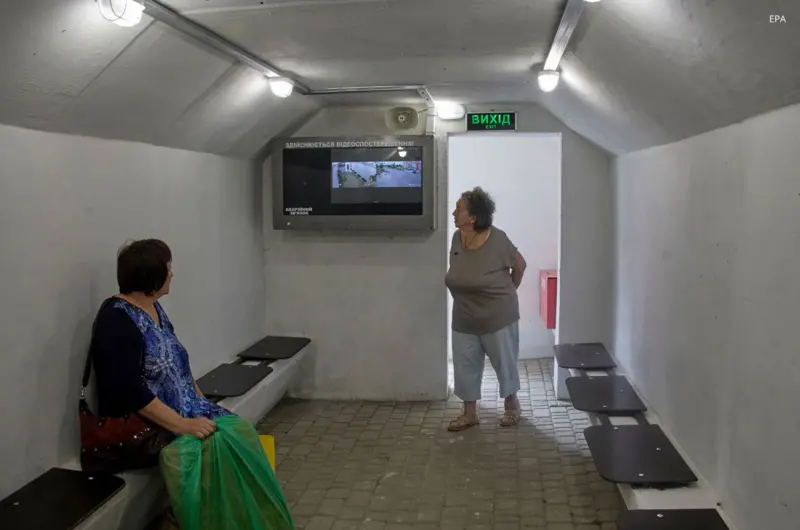
Почему, например, в Киеве и других крупных населенных пунктах не строятся остановки-укрытия?
Ответ на этот вопрос, по меньшей мере, странный. Оказывается, эффективной защите граждан препятствует устаревшая документация и украинская бюрократия.
Дело в том, что государственные строительные нормы (ГСН) в этой сфере не соответствуют сегодняшним вызовам, объясняет ВВС Украина инженер-проектировщик объектов гражданской защиты Сергей Святошенко.
Специалист объясняет, что первый ГСН, который касался укрытий, создан в Украине в 1997 году и был фактически переписан из советских строительных норм.
Уже во время войны разработали новый ГСН (название В.2.2-5:2023 «Защитные сооружения гражданской защиты»), который вступил в силу с ноября 2023 года, но и он оказался «морально устаревшим». К примеру, в нем вообще нет такого понятия как «модульные укрытия» или «остановки-укрытия»
«Этот ГСН рассчитан на времена холодной войны», — говорит Святошенко.

Именно на проблему с государственными строительными нормами указывает и Роман Ткачук, объясняя, почему в Киеве во время войны не строят модульные укрытия на улицах.
По его словам, городские власти не могут потратить бюджетные средства на объекты, создание которых не регулируется государственными строительными нормами.
«Возле каждой остановки поставить такое сооружение — это нормами ГСН не определено на сегодняшний день. И город Киев это не делает только потому, что ГСН не говорит, как это правильно сделать за бюджетные средства».
Более того, Ткачук уверяет, что города, которые все же установили модульные укрытия для защиты людей, сейчас попали под пристальное внимание аудиторов и правоохранителей.
«В других регионах — Харькове, Херсоне — где построены такие быстровозводимые конструкции, там уже Госаудит начал уголовные дела по этому поводу из-за их строительства», — уверяет Ткачук.
В чем проблема с ГСН
Что не так с этими строительными нормами? Во-первых, они вообще не содержат упоминания о возможности сооружения модульных защитных укрытий.
ГСН предусматривает создание только «сооружений двойного назначения», «убежищ» и «противорадиационных укрытий».
Во-вторых, в документе прямо сказано об отсутствии расчетов на случай прямого попадания боеприпасов или взрыва в непосредственной близости к стенам защитных сооружений. Соответственно, возникает вопрос, насколько защищенными будут люди внутри укрытий, построенных по этому ГСН.
В нормах также говорится об объектах рассчитанных на большие группы людей (от 500 до 2 тысяч) и на длительное время пребывания (до 48 часов), но это не имеет смысла в условиях современной войны.
«Основным опытом этой войны является необходимость рассредоточения. Этот принцип действует и на фронте и в тылу… Как только появляется концентрация гражданских или военных и враг имеет возможность поражения — он делает это», — объясняет руководитель строительной компании, также занимавшейся возведением военных объектов, Сергей Распутный.
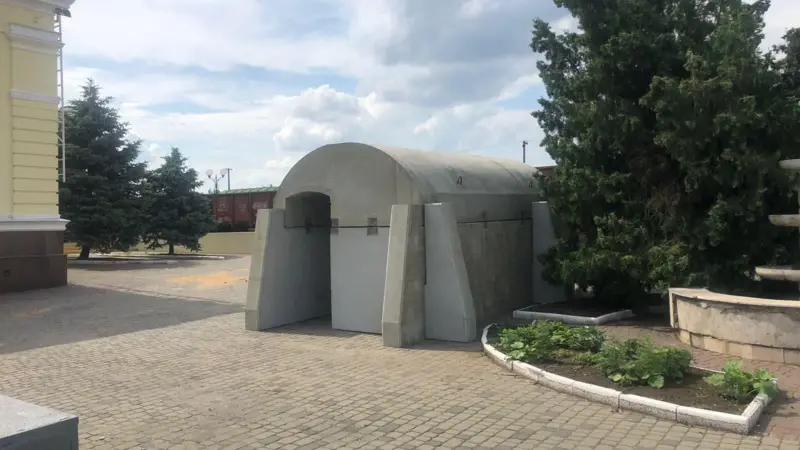
Также строительные нормы совершенно не учитывают время поражения объектов в разных городах. Очевидно, что оно существенно отличается, например, во Львове и Харькове. Если в первом от объявления тревоги до непосредственно прилета ракеты может пройти даже час, то во втором это иногда занимает секунды или 2-3 минуты.
«При ракетной опасности укрытия, которые расположены за пределами трехминутной досягаемости, — это бесполезное сооружение. Это абсолютно бессмысленно выброшенные средства», — считает эксперт.
Соответственно, ГСН должен был бы учитывать эту дифференциацию и ввести определенное «зонирование» по размещению защитных сооружений.
По мнению специалистов, необходимо вносить изменения в действующий ГСН и параллельно разрабатывать новые государственные строительные нормы. Где, в частности, будет прописана возможность возведения модульных укрытий.
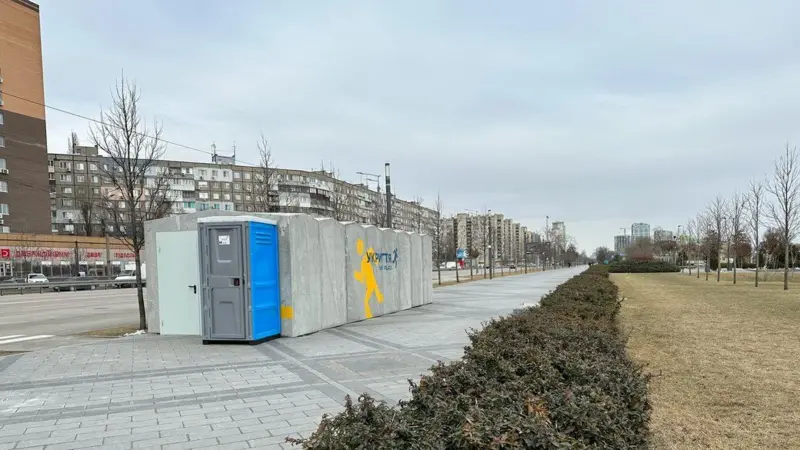
В Днепре местные власти начали устанавливать модульные быстровозводимые укрытия в парках и на остановках в конце 2022 — начале 2023 года
Следует заметить, что сейчас местные администрации и частные застройщики, которые устанавливают «остановки-укрытия», действуют на свой страх и риск, поскольку руководствуются не ДБН, а ДСТУ (государственный стандарт Украины).
Действительно, с первого марта прошлого года действует ДСТУ 9195:2022 («Быстровозводимые защитные сооружения гражданской защиты модульного типа»). Он устанавливает требования для проектирования и изготовления таких «остановок-укрытий» вместимостью до 50 человек.
«ГСН имеет более высокую силу, чем ДСТУ, и теоретически все эти действия могут стать предметом расследования правоохранителей», — допускает Сергей Святошенко.
В то же время заместитель министра стратегических отраслей промышленности Тимур Ткаченко не видит в этом проблемы.
«Если говорить о модульных укрытиях, то это регулируются ДСТУ, плюс сейчас в разработке есть новые стандарты, которые называются «Первичные укрытия», — сказал он.
Роман Ткачук считает, что следует разработать общегосударственную программу для установки модульных укрытий одного стандарта и по одним нормам, чтобы избежать проблемы для местных властей и защитить людей.
Без строителей и денег
Если даже власть примет такую общегосударственную программу, это не снимет ряд других проблем. В частности, с финансированием модульных укрытий.
Один из производителей таких сооружений сказал ВВС Украина, что их цена составляет от 2,7 до 4,2 млн гривен.
Понятно, что их надо не менее нескольких десятков, если не сотен, на город в зависимости от количества жителей.
Но кроме финансов есть еще проблема с кадрами. Так, сразу несколько руководителей строительных фирм сказали ВВС о проблеме с мобилизацией сотрудников-мужчин.
«Дефицит кадров действительно есть. Перед началом войны у меня, например, было 16 сотрудников, а теперь осталось только двое. Кто-то уехал, кого-то мобилизовали», — отметил один из них.
Заместитель главы минстратегпрома Тимур Ткаченко говорит, что ему известно об этой проблеме и он уже видит путь ее решения. Речь идет о бронировании работников предприятий, которые строят укрытие. Аналогичная схема уже действует в отношении тех, кто создает фортификации для фронта.
«Системное решение должно быть. По моему мнению, укрытия должны быть приравнены к фортификационным сооружениям. Я не могу принять такое решение, но я могу его инициировать. И я сейчас над этим работаю», — заявил он ВВС.
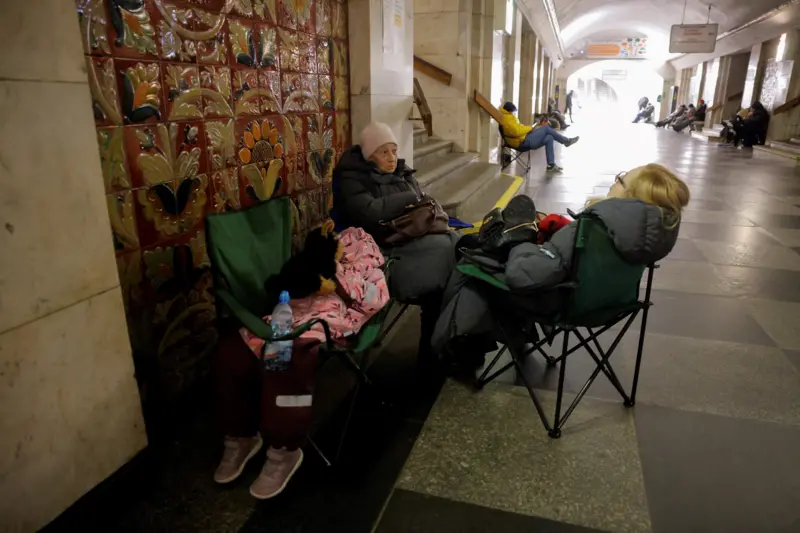
Все эти вроде бы мелкие проблемы накладываются друг на друга и в целом тормозят стратегически важный, по словам чиновников, процесс возведения защитных укрытий.
Правда, есть надежда, что в Киеве он в ближайшее время сдвинется с мертвой точки. ВВС из своих источников стало известно, что в начале июля столичные власти встретились с производителями модульных укрытий и «выразили заинтересованность в этих сооружениях».
Однако, источник в украинской власти указывает на еще один барьер, который не связан ни с финансами, ни с законодательством. Он связан с психологией чиновников.
«Некоторые руководители местной власти одного из городов откровенно говорили мне: зачем строить укрытия, если люди все равно туда не ходят, — указывает собеседник, — По иронии судьбы именно в этот город недавно прилетела ракета и были человеческие жертвы».


